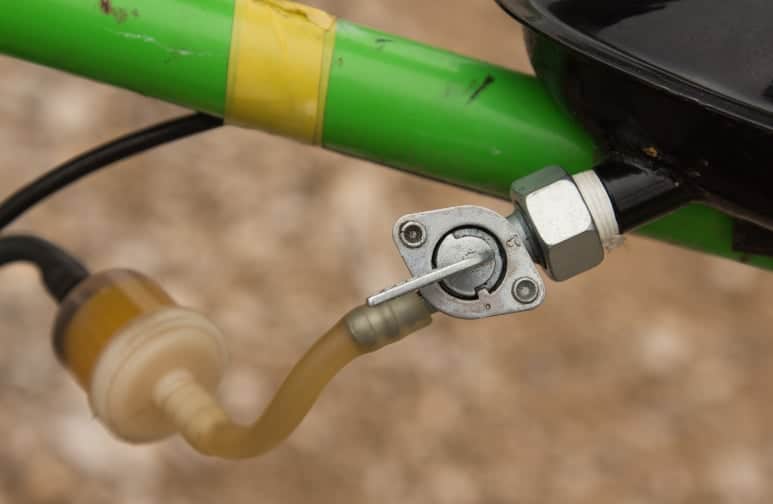
When I bought my first motorcycle and started looking around on forums as to why my motorcycle wouldn’t start I kept reading about a petcock and I was certain it must be a slang term for some part. But sure enough, that’s the actual name of a very important part of every motorcycle fuel system.
How does a petcock work? A petcock, or sometimes referred to as a fuel tap or fuel valve, is a 2 or 3 way valve on the bottom of your fuel tank. It works by directing fuel from your tank to the carburetors or fuel injectors. Fuel is pulled by either gravity or vacuum from the fuel system. Gravity fed systems are the most common and generally less troublesome.
The petcock is often overlooked when there are fuel delivery issues to the carburetors and they fail quite frequently. I’m going to go into more depth below on how they work, signs that it’s starting to go bad, and how to fix it.
How Does A Motorcycle Petcock Work?
The petcock can be turned to the OFF, ON, or RESERVE positions. When in the OFF position, no fuel is flowing from the tank to the carburetor. This is often used while storing the bike, even between rides. It is useful to keep fuel from flooding the engine in the case that the carburetor float is not sealed adequately.
Likewise, if there is an external fuel leak downstream from the petcock, turning it off will prevent that leak. A petcock can serve as a bit of a theft deterrent, but shouldn’t be relied on for that purpose.
When in the ON position, fuel is freely drawn from the tank to the carburetor. This allows the engine to operate. If you find the engine is hard to start, check that the fuel is turned on.
In the RESERVE position, fuel is also flowing from the tank to the carburetor, although from a different part of the tank. The ON position draws from the majority of the tank, but there is a small section at the very bottom that allows for a bit of fuel to be in “reserve.” This reserve is used to get the motorcycle somewhere to be fueled when the tank runs out of fuel.
Another purpose of the RESERVE position is to clear out the fuel tank. If water has accumulated, it will rest at the lowest point in the tank. By running on RESERVE, that water is allowed out of the tank and will get burned in the engine. This will limit the possibility of oxidation occurring inside the fuel tank.
A gravity-feed system is pretty straightforward. When in the ON or RESERVE position, fuel flows freely due to gravity. The seal of the petcock when manually turned to the OFF position stops fuel flow from the tank.
In a vacuum-operated system, an additional valve is added to what you would find on a gravity-feed system. This additional valve is operated by the vacuum of the engine. When there is no vacuum, a spring holds a small o-ring seal in place which stops the flow of fuel. When vacuum is applied, the diaphragm of the valve is pulled in which unstops the flow of fuel.
Signs Your Petcock May Be Malfunctioning
While a petcock is usually simple in theory, there are small parts that can wear out over time. There are a few common issues to be aware of.
First off, the petcock can leak. A leaking petcock makes a mess of gas down the side of the motorcycle and on the ground. There will also likely be a noticeable drip from the petcock or fuel lines. Leaking fuel is a waste of money and a huge fire hazard. A leak can be due to many different reasons, but we will cover the basics here.
Inside the petcock assembly, there are one or more gaskets or o-rings. These gaskets can wear out over time. Sometimes the gasoline will dry out the sealing material causing it to crumble. This displacement of gasket material causes the seal to be ineffective and allows fuel to leak.
Closely related are the vacuum diaphragm seals. These are found on fuel systems with a vacuum-operated petcock. The causation is similar to the gaskets or o-rings. The diaphragm material gets worn or torn and does not hold vacuum. This can cause fuel to leak through the petcock even when turned off.
It is also possible to get an internal leak. This occurs when the seals inside the petcock fail and allow fuel to flow from the tank to the carburetor. When this is the case and once the carburetor is flooded, fuel drains into the cylinder. This runs the risk of hydro locking the engine, which can be a big, expensive problem.
Also, from there gas leaks into the crankcase and dilutes the engine oil. It also overfills the crankcase and the oil/gas mixture will leak out onto the ground. This can be a big headache as you now need to not only replace the petcock but also the engine oil.
Some cases may lead you to believe the petcock is faulty, but it could be something else. A common example is a kinked fuel line. This can occur if the fuel line is improperly installed or if the tank has been taken off and reinstalled incorrectly. When the fuel line pinches, it chokes out the fuel supply and may trick you into believing that the petcock is blocking off fuel.
On some petcocks, there is a fuel screen on the tank-side. This screen prevents any residue from inside the tank from passing into the carburetor and causing problems. These filters will eventually require maintenance. If neglected, the fuel supply may be restricted or the screens may fail and allow debris through.
How To Fix A Broken Petcock
The specifics of replacing the petcock on your bike will depend on the make and model. However, there are some basics to follow to make a successful repair.
The first order of business is to work in a place that is well ventilated and where you have access to tools. This job will require draining the fuel tank, so also have a compatible container to catch it in. This can be done outside or in a ventilated garage. Turn the petcock to RESERVE as this will get all the fuel out.
Once the fuel is drained, you can remove the petcock. Having it out of the tank will make it easier to work on if you are replacing gaskets. Typically, the petcock will be threaded into the bottom of the tank. Put some masking tape on painted surfaces that you don’t want accidentally scratched by the wrench. Disconnect the fuel line and then turn the petcock counterclockwise until it is out.
At this point, if you are just replacing the petcock, things should be ready to go back together. Make sure the threads on the tank aren’t damaged and carefully install the new petcock. Tighten it according to instructions; otherwise, a firm torque will be sufficient. Don’t over tighten it or it could cause damage.
To take apart the petcock, you will likely need some screwdrivers and a pick. Be careful with small screws and other small parts of the assembly that can easily be lost. Have a reference handy for how the petcock goes back together.
Replace any gaskets or seals and reassemble then reinstall the assembly in the tank. Some aftermarket parts may come with instructions, so be sure to follow those recommendations.
Many petcocks are sealed from the factory using rivets instead of screws. These types of petcocks are not made to be fixed and should just be thrown away if they are bad. Petcocks are not expensive, so if you have a rivet style petcock just buy a new one.
Once the petcock is reinstalled, it would be wise to also replace the fuel line and hose clamps. Fuel hose and clamps can be purchased at most auto parts stores or hardware stores. Old fuel line is prone to leak and replacing it is a relatively inexpensive upgrade. After that, add some gas to the tank and check for leaks. Address any other leaks before firing up the engine.
How To Maintain Your Petcock?
Any component of a motorbike will eventually wear out from use. The fuel petcock is a component that may wear faster than others because it may get more use. They can also be cheaply made and the poor quality leads to an earlier failure.
The best maintenance you can do to prolong the life of the petcock is regular inspection. Before riding, check for any leaks or drips. Look on the ground for any spilled gas. Check the fuel lines for any cracks or loose fittings.
If you are concerned about the petcock getting worn out, you might plan to use it less. Vacuum-operated petcocks will still operate even in the OFF position as a safety feature. If your bike has this, there may be no reason to turn it on and off after every ride. You may opt to only turn the fuel off if the bike is going to sit for a long time or if you’re doing some work on it.
If you are fixing up or restoring a motorcycle, it wouldn’t hurt to replace the petcock. There are a lot of OEM replacements as well as aftermarket replacements available. Beware of cheap parts, but know that there are some quality parts out there, too. Upgrading this component during a rebuild will save some time and effort down the road.
